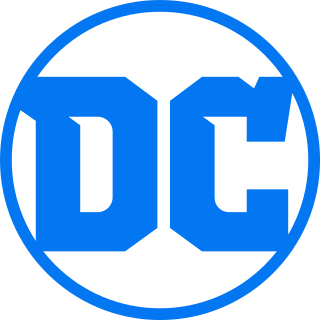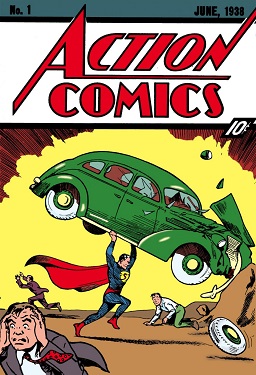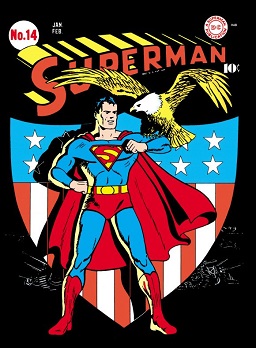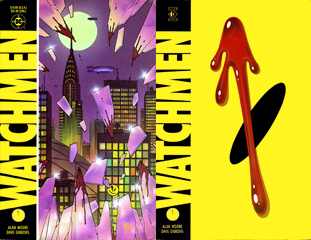
A comic book, also called comicbook, comic magazine or simply comic, is a publication that consists of comics art in the form of sequential juxtaposed panels that represent individual scenes. Panels are often accompanied by descriptive prose and written narrative, usually, dialogue contained in word balloons emblematic of the comics art form.

DC Comics, Inc. is an American comic book publisher and the flagship unit of DC Entertainment, a subsidiary of Warner Bros. Discovery.

Action Comics is an American comic book/magazine series that introduced Superman, one of the first major superhero characters. The publisher was originally known as National Allied Publications, and later as National Comics Publications and as National Periodical Publications, before taking on its current name of DC Comics. Its original incarnation ran from 1938 to 2011 and stands as one of the longest-running comic books with consecutively numbered issues. The second volume of Action Comics beginning with issue #1 ran from 2011 to 2016. Action Comics returned to its original numbering beginning with issue #957.

The Silver Age of Comic Books was a period of artistic advancement and widespread commercial success in mainstream American comic books, predominantly those featuring the superhero archetype. Following the Golden Age of Comic Books, the Silver Age is considered to cover the period from 1956 to 1970, and was succeeded by the Bronze Age.

The Golden Age of Comic Books describes an era in the history of American comic books from 1938 to 1956. During this time, modern comic books were first published and rapidly increased in popularity. The superhero archetype was created and many well-known characters were introduced, including Superman, Batman, Robin, Captain Marvel, Captain America, and Wonder Woman.

An American comic book is a thin periodical originating in the United States, on average 32 pages, containing comics. While the form originated in 1933, American comic books first gained popularity after the 1938 publication of Action Comics, which included the debut of the superhero Superman. This was followed by a superhero boom that lasted until the end of World War II. After the war, while superheroes were marginalized, the comic book industry rapidly expanded and genres such as horror, crime, science fiction and romance became popular. The 1950s saw a gradual decline, due to a shift away from print media in the wake of television and the impact of the Comics Code Authority. The late 1950s and the 1960s saw a superhero revival and superheroes remained the dominant character archetype throughout the late 20th century into the 21st century.

Nelson Alexander Ross is an American comic book writer and artist known primarily for his painted interiors, covers, and design work. He first became known with the 1994 miniseries Marvels, on which he collaborated with writer Kurt Busiek for Marvel Comics. He has since done a variety of projects for both Marvel and DC Comics, such as the 1996 miniseries Kingdom Come, which Ross co-wrote. Since then he has done covers and character designs for Busiek's series Astro City, and various projects for Dynamite Entertainment. His feature film work includes concept and narrative art for Spider-Man (2002) and Spider-Man 2 (2004), and DVD packaging art for the M. Night Shyamalan film Unbreakable (2000). He has done covers for TV Guide, promotional artwork for the Academy Awards, posters and packaging design for video games, and his renditions of superheroes have been merchandised as action figures.
Comic book collecting is a hobby that treats comic books and related items as collectibles or artwork to be sought after and preserved. Though considerably more recent than the collecting of postage stamps (philately) or books (bibliophilia), it has a major following around the world today and is partially responsible for the increased interest in comics after the temporary slump experienced during the 1980s.
In American comic books and other stories with a long history, first appearance refers to the first issue to feature a fictional character. These issues are often highly valued by collectors due to their rarity and iconic status.
Milestone Media Company LLC is a company best known for creating Milestone Comics, which were published and distributed by DC Comics, and the Static Shock animated series. It was founded in 1993 by a coalition of African-American artists and writers, consisting of Dwayne McDuffie, Denys Cowan, Michael Davis, Derek T. Dingle, and Christopher Priest. The founders felt that minorities were severely underrepresented in American comics and wished to address this.

The Modern Age of Comic Books is a period in the history of American superhero comic books which began in the mid-1980s and continues through the present day. During approximately the first 15 years of this period, many comic book characters were redesigned, creators gained prominence in the industry, independent comics flourished, and larger publishing houses became more commercialized.
In comic books, a variant cover refers to an issue of a comic book printed with multiple covers, each with unique cover art. The first comic book marketed with a variant cover was the 1986 first issue of The Man of Steel, which featured two different covers by writer/artist John Byrne. Variant covers became more common during the "speculator boom" of the 1990s, when more collectors became interested in the storage and preservation of their comic books with the goal of future financial gain rather than reading the comics themselves.
Certified Guaranty Company, also known as CGC, is a Sarasota, Florida comic book grading service. CGC is an independent member of the Certified Collectibles Group of companies. It is the first independent and impartial third party grading service for comic books.

Action Comics #1 is the first issue of the original run of the comic book/magazine series Action Comics. It features the first appearance of several comic-book heroes—most notably the Jerry Siegel and Joe Shuster creation, Superman—and sold for 10 cents. It is widely considered to be both the beginning of the superhero genre and the most valuable comic book in the world. Action Comics would go on to run for 904 numbered issues before it restarted its numbering in the fall of 2011. It returned to its original numbering with issue #957, published on June 8, 2016 and reached its 1,000th issue in 2018.

Superhero fiction is a subgenre of science fiction examining the adventures, personalities and ethics of costumed crime fighters known as superheroes, who often possess superhuman powers and battle similarly powered criminals known as supervillains. The genre primarily falls between hard fantasy and soft science fiction in the spectrum of scientific realism. It is most commonly associated with American comic books, though it has expanded into other media through adaptations and original works.

Tom Taylor is an Australian comic book writer, playwright and screenwriter. A New York Times bestselling author, his work includes DC Comics series Injustice, DCeased, Nightwing, Superman, Suicide Squad and Marvel series All-New Wolverine, X-Men Red, Superior Iron Man and Star Wars comics.

The Network of Disclosure was a group of comic book dealers and collectors who pledged to disclose any form of restoration or enhancement, known to exist, on a comic book whose ownership is to be transferred to another party through sale, trade or gift. The NOD, founded in early 2006, was the only comic book collecting educational organization in the world. The objective of the organization was to create a safer and more open environment for those buying and selling comic books. By publicly sharing this type of history of each of these books with fellow collectors and customers, the group sought to foster both a greater level of confidence and sense of security within the marketplace.
The history of American comics began in the 19th century in mass print media, in the era of sensationalist journalism, where newspaper comics served as further entertainment for mass readership. In the 20th century, comics became an autonomous art medium and an integral part of American culture.
OrlandoCon, also known as O'Con, was a long-running comic book and comic strip fan convention which was held annually between 1974 and 1994 in Orlando, Florida. The first comics convention held in the Orlando area, OrlandoCon billed itself as the "Central Florida comic art convention and early TV/film festival." Captain Marvel-creator C. C. Beck was a regular guest of the show; as were many other Golden Age comics creators who lived in the Orlando area.

A comic book convention or comic con is a fan convention with a primary focus on comic books and comic book culture, in which comic book fans gather to meet creators, experts, and each other. Commonly, comic conventions are multi-day events hosted at convention centers, hotels, or college campuses. They feature a wide variety of activities and panels, with a larger number of attendees participating in cosplay than most other types of fan conventions. Comic book conventions are also used as a vehicle for industry, in which publishers, distributors, and retailers represent their comic-related releases. Comic book conventions may be considered derivatives of science-fiction conventions, which began in the late 1930s.









